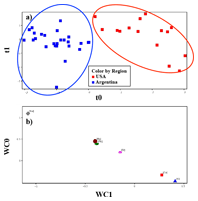Access Agilent eNewsletter, January 2015
>> Update My Profile | Subscribe to Access Agilent | Article Directory

Assessing food authenticity by profiling metal content
By John Lee
Agilent Food Market Manager
Some food producers will use claims of authenticity, quality, status, or origin as a way of justifying higher prices for their products. This practice can present a dilemma for consumers and regulators – can you trust the label? Is this product really from country x – or is it a blend of cheaper ingredients from a range of countries? In fact, many high value foods have characteristic features derived from their chemical components, which can be used to identify origin or adulteration. Food producers can utilize these distinct features to control their processing of raw materials and ensure the final product will meet consumer expectation. Agilent offers several classes of analysis to determine the origin of food or its raw materials, including HPLC, GC, LC/MS, GC/MS, infrared spectroscopy and fluorescence spectroscopy. In this article, we highlight two different atomic spectroscopy approaches to assess the metal profile of foods as an aid to origin identification and authenticity.
Comparing wine from North and South America with MP-AES
In the USA, consumers increasingly favor wine made from Malbec grapes. Argentinean exports of Malbec wine to the US have grown from 50,000 cases in 2000 to over 1.4 million cases in 2009, but there are increased concerns about its origin. Different techniques have profiled the elemental content of wines to identify geographical origin. Recently, a team from the Food Safety & Measurement Facility at the University of California, led by Helene Hopfer and Sue Ebeler, studied Malbec grapes using microwave plasma – atomic emission spectroscopy (MP-AES) with an Agilent 4200 MP-AES to produce an elemental model of Sr, Rb, Mg, Ca, Na, and K. The grapes came from over 40 vineyards in Argentina and the US. All samples came from grapes harvested in 2011 and all sites employed the same winemaking procedure. The six elements were found in the different wine samples with concentrations above their LODs. The samples also differed significantly between the USA and Argentina (P ≤ 0.05) (see Table 1).
California |
Mendoza |
|||||||
|---|---|---|---|---|---|---|---|---|
Wavelength (nm) |
Detection Limit (ppm) |
x |
σx |
min - max |
x |
σx |
min - max |
|
Sr |
407.771 |
0.0018 |
0.45 |
0.02 |
0.241 - 0.832 |
0.77 |
0.04 |
0.423 - 1.586 |
Rb |
780.027 |
0.0004 |
3.37 |
0.03 |
0.565 - 7.833 |
0.99 |
0.02 |
0.549 - 2.190 |
Mg |
279.553 |
0.0012 |
80.87 |
0.42 |
61.746 - 144.857 |
72.87 |
0.54 |
53.551 - 116.287 |
Ca |
396.847 |
0.0016 |
51.78 |
0.19 |
43.260 - 74.008 |
50.46 |
0.25 |
33.216 - 95.078 |
Na |
589.592 |
0.0007 |
4.9 |
0.09 |
3.381 - 8.463 |
37.48 |
0.48 |
13.706 - 121.871 |
K |
769.897 |
0.002 |
1444.4 |
10.5 |
1120.935 - 2219.835 |
1181.2 |
15.5 |
976.854 - 1989.117 |
Table 1. Detection limits of six elements in Malbec wines from Argentina and California, with element concentrations that were significantly different between different wineries (P ≤ 0.05).
 Enlarge
Enlarge
Figure 1. Partial least squares-discriminant analysis (PLS-DA) of six elements in wines from Argentina and California, showing (top) the separation of the wines by origin and (bottom) the first dimension separation.
The team used Agilent Mass Profiler Professional (MPP) software for their chemometric analysis. After exploratory investigation with principal component analysis, partial least squares-discriminant analysis (PLS-DA) was employed to investigate the six elements that differed significantly between the wine samples (Figure 1).
The Agilent 4200 MP-AES is an easy-to-use, low-cost instrument for geographical origin analysis on wine samples when combined with MPP. It can be used as a quality control tool in the wine making process for metals such as K, Ca, and Fe, which can can produce precipitates, cause cloudiness, or affect the taste, as described in Agilent publication 5991-1586EN.
Origins of Chinese honey identified by ICP-MS
Hui Chen et al. developed a rapid and simple ICP-MS method for multi-element profiling of the origins of four important types of Chinese honey. The authors assessed 12 mineral elements, some of which needed detection at very low levels, with an Agilent 7700x ICP-MS and chemometric tools. The model-training process took data from 121 honey samples and employed a back-propagation artificial neural network (BP-ANN) model. All samples were successfully classified into the four groups. The validation of the BP-ANN model was then assessed by an independent test set of 42 honey samples, with an overall prediction accuracy of 97.6% (all except one incorrect identification), demonstrating the applicability of this approach (Table 2).
Actual |
Predicted |
||||
|---|---|---|---|---|---|
Linden |
Vitex |
Rape |
False acacia |
Accuracy (%) |
|
Linden |
10 |
0 |
0 |
0 |
100 |
Vitex |
0 |
13 |
0 |
0 |
100 |
Rape |
0 |
0 |
5 |
0 |
100 |
False acacia |
0 |
0 |
1 |
13 |
92.3 |
Prediction accuracy (%) |
|
97.6 |
|||
Table 2. Predicting the identity of Chinese honey using a BP-ANN model
The Agilent 7700x provides the ideal combination of robustness and the analytical range necessary to cover the very different concentration spans of these metals found in honey samples. In addition, the 7700x offers productivity benefits over the more time-consuming organic chemistry techniques also considered by the Chinese Academy of Inspection and Quarantine.
ICP-MS distinguishes wine processes in the US
Researchers at the University of California Davis (UCD) have also used ICP-MS to profile geographic origin of red wines. Recently, a UCD publication described wine production in different vineyards and different processing facilities in northern California. The authors assessed whether the processing variable could be differentiated simultaneously, an even more complex investigation because numerous grape varieties were also part of the study. ICP-MS was necessary because of its ability to measure dozens of elements covering a wide dynamic range. There were significant differences for 26 elements among five vineyards and for 33 elements among five processes. Thus, identifying the origin of food can be complicated, because even before it is transported, our food often takes a complex journey simply to be created.
Food solutions with integrity
Agilent has many advanced measurement solutions perfectly suited to profiling food products, whether identifying contaminants or building classification models to assess authenticity. Learn how Agilent’s food profiling methodology combines highly evolved food testing solutions with Agilent Mass Profiler Professional (MPP) software in delivering superior automation capabilities and accelerated data analysis.
>> Update My Profile | Subscribe to Access Agilent | Article Directory
